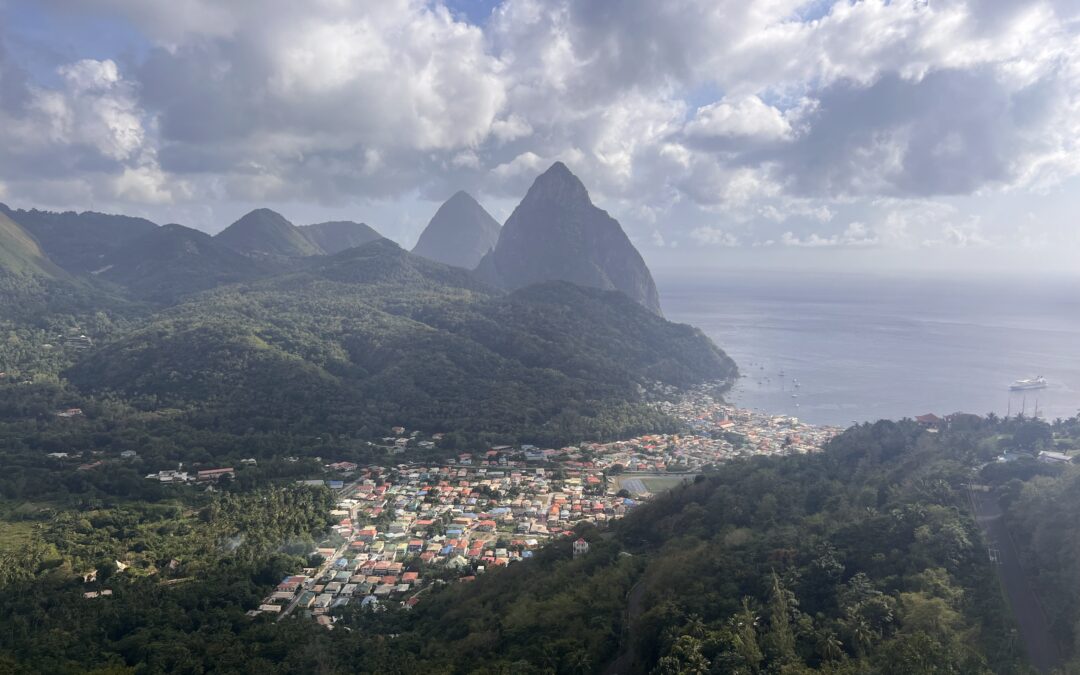Table of Contents
History of Saint Lucia
St. Lucia is an island in the Caribbean with a rich history that began long before European arrival. Originally, the island was inhabited by indigenous peoples, such as the Arawaks and the Caribs. These groups lived on the island for centuries, creating villages and a way of life centered around fishing and agriculture. The island’s name comes from St. Lucy of Syracuse, and the island was named by French sailors in the 16th century.
In the early 1600s, the island was claimed by both the French and the British, leading to many battles for control. The French built forts and established plantations, mainly growing sugar, but the British took control of the island in the 19th century. This back-and-forth between the French and the British continued for over 100 years, with the British eventually gaining permanent control in 1814. The British brought enslaved Africans to work on the sugar plantations, shaping much of St. Lucia’s culture and population.
St. Lucia gained its independence from Britain on February 22, 1979, becoming a sovereign nation. Since independence, the country has worked to grow its economy, focusing on tourism, agriculture, and services. Today, St. Lucia is known for its stunning natural beauty, including the famous Pitons (two volcanic mountains), and a vibrant culture that blends African, French, and British influences. It remains a popular tourist destination in the Caribbean.
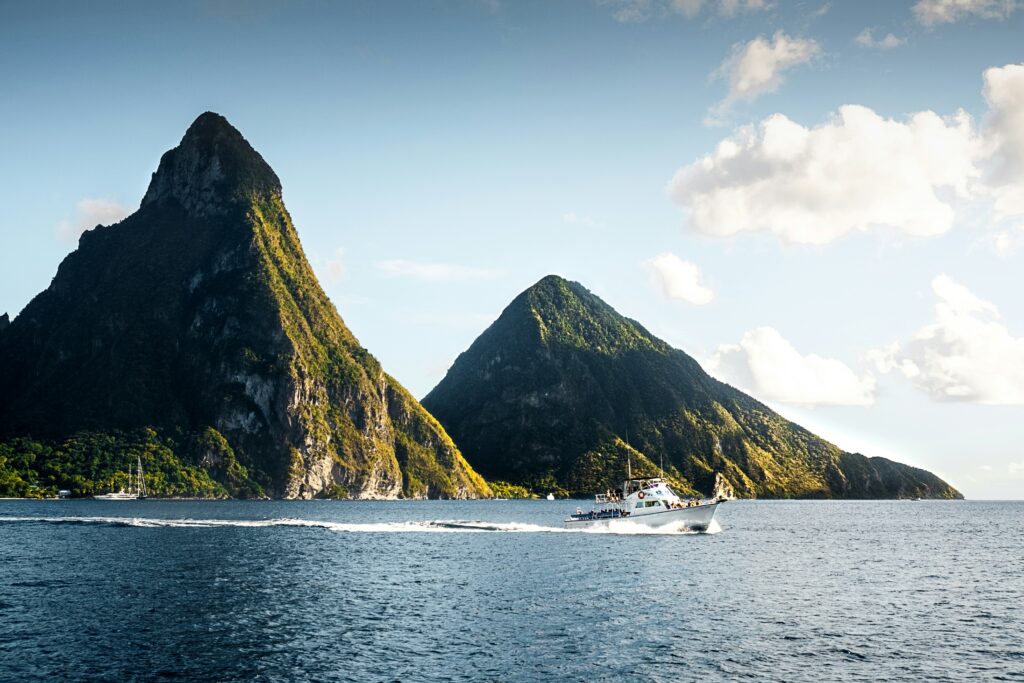
Culture of Saint Lucia
Saint Lucia is a beautiful Caribbean island with a vibrant and diverse culture, shaped by a blend of African, French, and English influences. While English is the official language, you’ll also hear Kwéyòl, or Saint Lucian Creole, spoken widely, which adds a unique flavor to the island’s character. The predominantly Catholic population enjoys a tolerant and harmonious religious atmosphere. This mix of cultures is reflected in Saint Lucia’s lively festivals, music, food, and art, making it a perfect destination for travelers wanting to experience authentic Caribbean culture.
The island is home to several exciting cultural festivals throughout the year, including La Woz (“The Rose”) and La Magwit (“The Marguerite”), celebrated in late August and October. These events are marked by colorful parades, music, and traditional performances. Another highlight is Creole Day (Jounen Kwéyòl) on the last Sunday of October, where locals dress in traditional Madras fabrics, serve delicious local dishes like bouyon (a hearty stew), green figs with saltfish, and share the island’s heritage through music and dance. The Saint Lucia Jazz Festival, which has been running since 1991, attracts global music lovers and showcases the island’s rich musical traditions, including calypso, soca, zouk, and reggae.
Saint Lucia’s culinary scene is just as diverse, with dishes influenced by African, French, and Indian flavors. You can enjoy local favorites like green banana and saltfish, macaroni pie, and mouth-watering curry dishes. The island’s art scene is also noteworthy, with talented artists like Sir Dunstan St. Omer contributing to the Caribbean’s artistic legacy. Whether you’re enjoying the lively music, indulging in delicious food, or exploring the vibrant art, Saint Lucia offers an unforgettable experience for anyone looking to immerse themselves in the heart of the Caribbean.
The Best Way to Travel to Saint Lucia
To get to Saint Lucia, you can travel via plane, ferry, or take one of the many cruises that dock on the island.
Getting to Saint Lucia by Plane
This will probably be the most common mode of travel to get to Saint Lucia. Saint Lucia has two airports:
- Hewanorra International Airport (UVF) – the main international airport located on the southern tip of the island near the town of Vieux Fort.
- George F. L. Charles Airport (SLU) – the secondary, regional airport located near the cruise port in Castries on Vigie Peninsula.
Direct Flights into Hewanorra International Airport (UVF)
Hewanorra International Airport (UVF) is the main airport located just outside Vieux Fort, Saint Lucia. It serves as a key gateway to the southern Caribbean region. It accommodates a variety of international travelers, providing vital connections to major cities across North America, the Caribbean, and Europe. This accessibility makes it a convenient entry point for tourists and business visitors alike, linking Saint Lucia to numerous destinations through direct flights operated by multiple airlines. Below is an updated list of airports offering direct service to Hewanorra International Airport (UVF) as of May 2025:
- 🇦🇬 Antigua V. C. Bird International Airport (ANU) via Sunrise Airways from Antigua, Antigua and Barbuda
- 🇺🇸 Boston Logan International Airport (BOS) via JetBlue Airways from Boston, Massachusetts, USA
- 🇺🇸 Charlotte Douglas International Airport (CLT) via American Airlines from Charlotte, North Carolina, USA
- 🇺🇸 Chicago O’Hare International Airport (ORD) via United Airlines from Chicago, Illinois, USA
- 🇬🇧 East Midlands Airport (EMA) via Avcon Jet from Derby, England, UK
- 🇬🇾 Georgetown Cheddi Jagan International Airport (GEO) via British Airways from Georgetown, Guyana
- 🇺🇸 Hartsfield-Jackson Atlanta International Airport (ATL) via Delta Air Lines from Atlanta, Georgia, USA
- 🇺🇸 John F. Kennedy International Airport (JFK) via JetBlue Airways from New York, New York, USA
- 🇬🇧 London Gatwick Airport (LGW) via British Airways from London, England, UK
- 🇬🇩 Maurice Bishop International Airport (GND) via British Airways from Port Salines, Grenada
- 🇺🇸 Miami International Airport (MIA) via American Airlines from Miami, Florida, USA
- 🇺🇸 Newark Liberty International Airport (EWR) via United Airlines from Newark, New Jersey, USA
- 🇺🇸 Philadelphia International Airport (PHL) via American Airlines from Philadelphia, Pennsylvania, USA
- 🇩🇴 Santiago de los Caballeros Cibao International Airport (STI) via Amerijet International from Santiago de los Caballeros, Dominican Republic
- 🇹🇹 ANR Robinson International Airport (TAB) via British Airways from Scarborough, Trinidad and Tobago
- 🇨🇦 Toronto Pearson International Airport (YYZ) via WestJet or Air Canada from Toronto, Ontario, Canada
View the full, up-to-date list here.
Direct Flights into George F. L. Charles Airport (SLU)
George F. L. Charles Airport (SLU), also known as Vigie Airport, is located in Castries, the capital of Saint Lucia. Serving as the island’s primary domestic and regional gateway, SLU offers convenient access to the northern part of Saint Lucia, including popular destinations like Rodney Bay and Marigot Bay. The airport is well-connected to neighboring Caribbean islands, facilitating travel for both tourists and other West Indies locals. With a single terminal and a focus on short-haul flights, SLU provides a more relaxed and efficient travel experience compared to larger international airports. As of May 2025, George F. L. Charles Airport offers direct flights to several destinations in the Caribbean, including:
- 🇩🇲 Melville Hall Airport (DOM) via InterCaribbean Airways or Sunrise Airways from Dominica, Dominica
- 🇻🇨 Argyle International Airport (SVD) via Sunrise Airways or Winair from Kingstown, Saint Vincent and the Grenadines
- 🇧🇧 Grantley Adams International Airport (BGI) via InterCaribbean Airways or Caribbean Airlines from Bridgetown, Barbados
- 🇬🇩 Maurice Bishop International Airport (GND) via Sunrise Airways or InterCaribbean Airways from Point Salines, Grenada
- 🇦🇬 Antigua V. C. Bird International Airport (ANU) via Sunrise Airways from Antigua, Antigua and Barbuda
- 🇹🇹 Piarco International Airport (POS) via Caribbean Airlines from Port of Spain, Trinidad and Tobago
- 🇬🇵 Pointe-à-Pitre International Airport (PTP) via Caribbean Airlines from Pointe-à-Pitre, Guadeloupe
- 🇸🇽 Princess Juliana International Airport (SXM) via Winair from Sint Maarten, Sint Maarten
- 🇵🇷 Luis Muñoz Marín International Airport (SJU) via Tradewind Aviation from San Juan, Puerto Rico
View the full, up-to-date list here.
How to Take a Ferry to Saint Lucia
Did you know that you can take a ferry to Saint Lucia if you are on one of the nearby Caribbean Islands? L’Express des Îles is the company that runs the inter-island ferry services. As of May 2025, you can travel to Saint Lucia via ferry on the following routes:
- 🇲🇶 Fort-de-France, Martinique to 🇱🇨 Castries, Saint Lucia (1 hour 30 minutes)
- 🇩🇲 Roseau, Dominca to 🇱🇨 Castries, Saint Lucia (4 hours 30 minutes)
- 🇬🇵 Pointe-à-Pitre, Guadeloupe to 🇱🇨 Castries, Saint Lucia (7 hours 15 minutes)
You can find an updated route list and timetable for departures on Direct Ferries.
Traveling by ferry to Saint Lucia is generally a pleasant and scenic experience, offering travelers picturesque views of the Caribbean Sea and surrounding islands. These modern ships are typically comfortable, providing amenities such as air-conditioned cabins, comfortable seating, restrooms, and snack bars. Although seas can occasionally become choppy depending on weather conditions, the ferry experience is generally smooth and enjoyable, making it a convenient and affordable way to explore multiple islands during your Caribbean adventure.
Taking a Cruise to Saint Lucia
Cruise tourism plays a significant role in Saint Lucia’s economy, bringing thousands of visitors each year who contribute directly to local businesses and artisans. Passengers typically have the chance to explore vibrant local markets, indulge in authentic Caribbean cuisine, or participate in excursions like snorkeling, hikes, or visiting historical sites such as Pigeon Island National Park. However, travelers should be mindful that cruising often means limited time ashore—usually only a single day—making thoughtful planning essential to fully experience the island’s diverse attractions.
Traveling to Saint Lucia by cruise ship offers visitors a scenic, leisurely approach to discovering the beauty and culture of this Caribbean gem. As the ship glides into the harbor of Castries, passengers are greeted by panoramic views of emerald-green mountains and brightly colored colonial buildings.
Visitors are encouraged to support local economies directly by shopping at markets run by Saint Lucian artisans, dining at locally owned restaurants, and choosing guided tours that emphasize sustainability and cultural respect.
As of May 2025, the following cruise ship companies offer cruises to Saint Lucia:
- Azamara Cruises
- Carnival Cruises
- Celebrity Cruises
- Cunard
- Disney Cruise Line
- Holland America Line
- MSC Cruises
- Norwegian Cruise Line
- Oceania Cruises
- Princess Cruises
- Royal Caribbean Cruises
- Silversea Cruises
- Virgin Voyages Cruises
- WindStar Cruises
- and more!
When is the Best Time of Year to Travel to Saint Lucia?
The best time to visit Saint Lucia is generally from December through April. This is the island’s dry season, so you can expect plenty of sunshine, warm temperatures, and minimal rain. It’s the ideal weather for lounging on the beaches, snorkeling in clear waters, and hiking the famous Pitons. Since this is also peak tourist season, especially around the holidays, you might find the island a bit busier and prices for flights and hotels a bit higher. But many travelers feel the great weather and vibrant atmosphere are well worth it.
If you’re looking for a quieter, more budget-friendly option, consider visiting during the shoulder months of November or May. The weather is still generally good, with fewer crowds and often better deals on accommodations and activities. However, it’s best to avoid the official hurricane season from June to November, when rain showers and storms are more common and can disrupt your plans. While the summer months can be less expensive, the risk of poor weather makes them a bit less reliable for a perfect tropical getaway. So, for the best overall experience, aim for December to April, but if you’re flexible, November and May can be great too!
How to Get Around in Saint Lucia
The best ways to travel once on the island are to take public transportation in the form of minibuses, hire a taxi driver, or rent a car.
Public Transportation in Saint Lucia
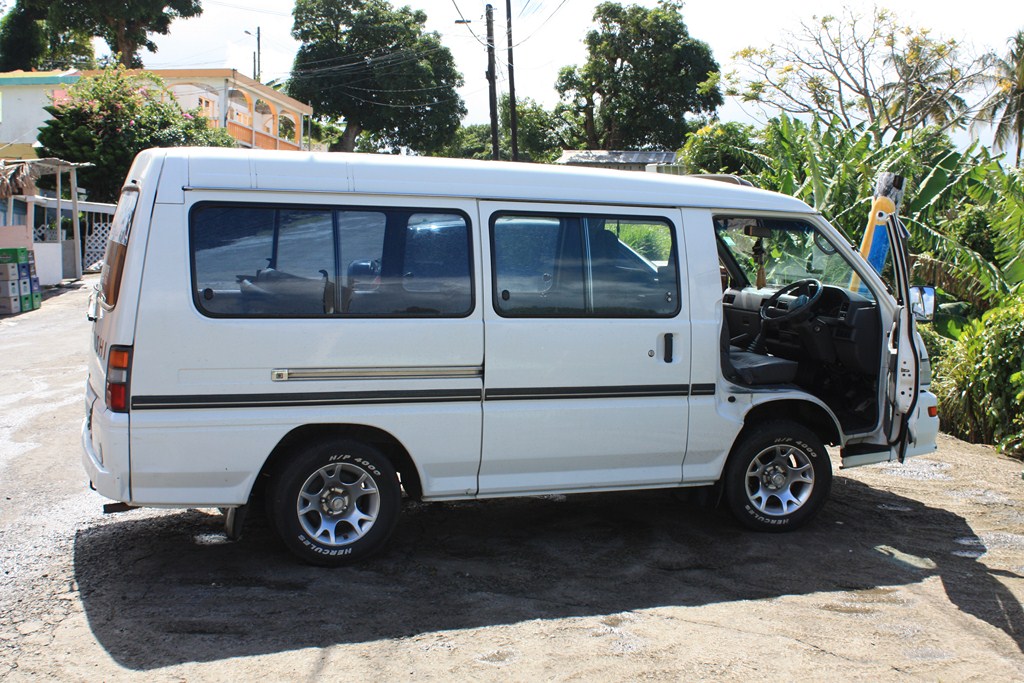
Minibuses are the heartbeat of local transportation in Saint Lucia. These privately operated vans, identifiable by their green license plates with an “M” prefix, offer an authentic and budget-friendly way to explore the island. Fares typically range from EC$2.50 to EC$8.00 (approximately $1 to $3 USD). While they provide a window into daily life and are great for mingling with locals, be prepared for crowded conditions and unpredictable schedules, as they depart once full. Although you can bring children and infants onboard, you won’t be permitted time to install carseats, and the overall ride might be too cramped to travel comfortably with little ones. Minibuses primarily serve major towns and routes, so they might not reach more remote attractions.
Hiring a Taxi or a Personal Driver
Taxis are a popular choice for a more comfortable and direct mode of transportation. Recognizable by their light blue license plates with a “TX” prefix, taxis are available at stands and airports, and they can also be booked in advance. It’s advisable to confirm the fare before starting your journey, as rates vary based on destination, number of passengers, and luggage. Taxis are more expensive than minibuses, but still an affordable method to take when trying to get across town.
You can also hire a personal driver for the day. Oftentimes, they are taxi drivers who will lend their local knowledge of the island while they drive you to your destinations. I would recommend using this mode of transportation if you only have one or two days of outings planned that require a longer-haul vehicle to travel. They will wait for you at every destination, so you don’t have to flag down a new taxi driver after every excursion. If you’re staying at an AirBNB or a residence managed by locals, they’ll often have reputable contacts for taxis and personal drivers. For a full day (approximately 7–9 hours), rates typically range from $150 to $250 USD for up to four passengers. This price often includes a private, air-conditioned vehicle, a knowledgeable local driver, and sometimes bottled water or light refreshments.
Renting a Car in Saint Lucia
Renting a car allows you to explore Saint Lucia at your own pace. A valid driver’s license from your home country is required, and visitors must obtain a temporary local permit upon arrival (usually between $15 to $30 USD). You can also obtain an International Driver’s License (IDL) from your home country before coming. This is usually the cheapest option for driving permits. Car rental agencies are available at both airports and throughout the island, offering a range of vehicles from compact cars to 4x4s, which are recommended for navigating the island’s varied terrain.
The roads in Saint Lucia are very different than the normal driving that you may be used to in the United States or Europe. Roads in most Caribbean nations, Saint Lucia included, tend to be windy and steep, as the whole island is basically a mountain. You can expect there to be potholes scattered throughout most roads, narrow road width, and no shoulder in many parts of the roadway. Although most foreigners find driving to be too nerve-wracking, this was the route that we chose when visiting Saint Lucia. We rented a small car from a local company (Discover Soufriere) and picked it up from the concierge at the airport upon arrival. They were very kind and showed us all the quirks and features of the car, helped us complete paperwork, and then sent us on our way!
We traveled with our 11-month-old baby, and as I have had many experiences driving in similar circumstances, we chose the rental car route so that we could travel on our own schedule, install his car seat for safety, and allow us to go at a slower pace if needed due to his unpredictable schedule. This worked perfectly for us, and we had no issues travelling during our trip. If you choose this method of transit while on the island, just be sure to familiarize yourself with local driving laws and signage, and be sure to allow more experienced locals to pass when it is safe to do so. It may seem like the most intimidating option, but it was perfect for us and enabled us to see all parts of the island without breaking the bank!
Things to do in Saint Lucia
There are a million things to do in Saint Lucia, but here is a list of our top 10 favorite things we did while there! All of these activities are safe and easy to do with an infant or young children, which was how we catered our itinerary!
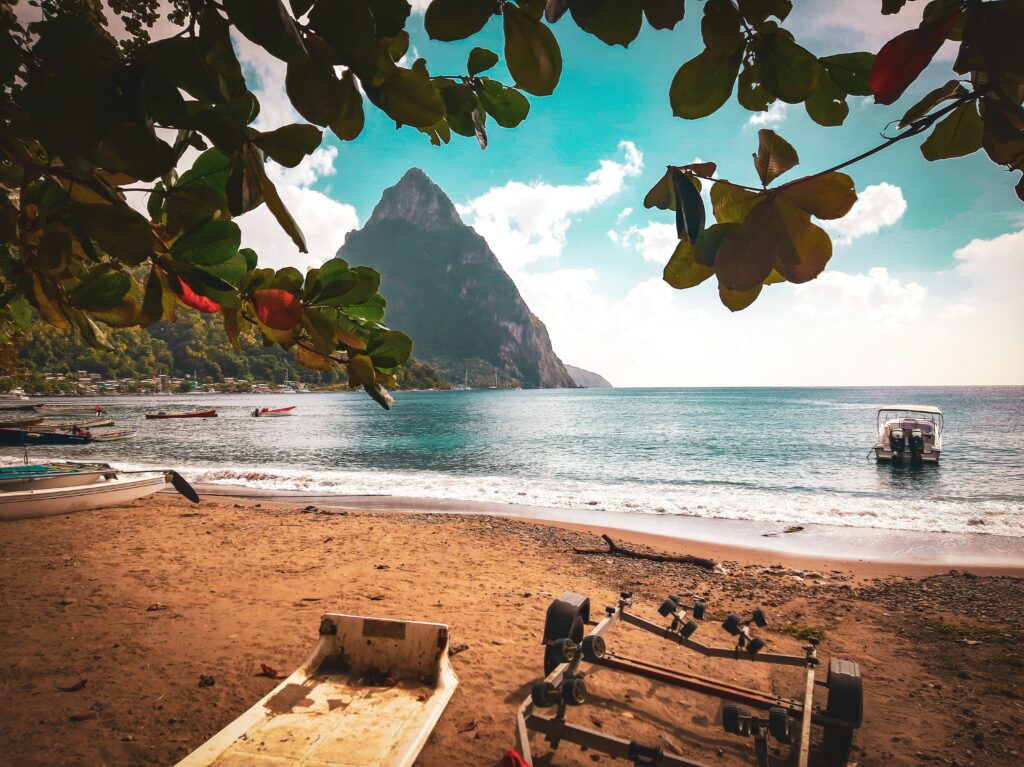
Spend Time at the Beach
Saint Lucia’s beaches offer the perfect blend of natural beauty, relaxation, and adventure, making it a top Caribbean destination for travelers. The nice thing is that all beaches in Saint Lucia are considered public property. Even if they’re within the boundaries of a resort, everyone can still access the beach portion and enjoy the water without spending an arm and a leg to stay there.
The most famous beach is nestled between the iconic Pitons, Sugar Beach (or Jalousie Plantation Beach as the locals know it) provides stunning views and luxury amenities—while it’s part of a resort, day visitors can access public areas, rent beach chairs, and enjoy seaside dining. When you arrive, just let the guards at the gate know you’re there for the beach and you can park inside the resort if they aren’t full, so be sure to get there early. If they are full, then you can park outside and make the walk down a steep hill until you are able to be picked up by a shuttle. Although going to the beach is free, be warned, food and optional amenities are expensive, but totally worth the money to make the most of a day on the perfect beach!
Reduit Beach in Rodney Bay is ideal for families and beachgoers looking for calm waters, nearby restaurants, and water sports like jet skiing and paddleboarding. This is where we spent the majority of our beach time, as it was easy to get to with a short 30 minute drive from where we were staying in Castries. Parking is plentiful (right by the police station) and food options were everywhere. You may get approached by locals wanting to help you find beach chairs and umbrellas, but they are all extremely kind and not harmful at all. IF you’d rather make your own setup in the sand, just politely decline their offer and make your way to the perfect spot! Although the view of the Pitons is absent compared to Sugar Beach, it is the perfect beach for those that have little ones, or just want to take it slow.
Anse Chastanet Beach, located near Soufrière on Saint Lucia’s west coast, is a peaceful and scenic spot known for its incredible snorkeling and diving. Just a short swim from the shore, the coral reef is full of colorful fish, sea turtles, and other marine life, all protected as part of a marine reserve. The beach features soft dark sand, palm trees, and plenty of space to relax. Visitors can rent snorkeling gear, kayaks, and paddleboards, or book a dive through the on-site PADI Dive Center. A short walk away is Anse Mamin, a quieter beach with a great beachside grill.
To make the most of your beach days, bring sunscreen, water shoes, and snorkeling gear, and take time to explore both the popular and secluded spots around the island.
Visit the World’s Only Drive-In Volcano
Nestled near the town of Soufrière on Saint Lucia’s southwestern coast, Sulphur Springs is known as the world’s only drive-in volcano. This unique geothermal attraction allows visitors to drive right up to the edge of a dormant volcanic crater, where they can witness bubbling mud pools, steaming fumaroles, and mineral-rich hot springs. The area, part of the Qualibou caldera, last erupted over 200 years ago and now offers a safe yet fascinating glimpse into the island’s volcanic origins. Guided tours provide insights into the geology and history of the site, making it an educational experience as well.
One of the highlights of a visit to Sulphur Springs is the opportunity to indulge in the therapeutic mud baths. These natural pools are filled with warm, mineral-laden mud believed to have healing properties for the skin and muscles. After applying the mud and allowing it to dry, visitors can rinse off in nearby showers or under cascading waterfalls. It’s recommended to wear dark-colored swimwear, as the sulfur can stain lighter fabrics. The combination of natural beauty, relaxation, and a touch of adventure makes Sulphur Springs a must-visit destination for anyone traveling to Saint Lucia.
Take a Hike
Saint Lucia offers a variety of hiking experiences, from leisurely walks to challenging climbs. The Tet Paul Nature Trail, located near Soufrière, is a family-friendly hike that takes about 45 minutes to complete. Open daily from 8 a.m. to 5 p.m., the trail provides panoramic views of the Pitons, Jalousie Bay, and even the neighboring islands of Martinique and St. Vincent. The entrance fee is $10 USD per person, which includes access to the trail and optional guidance from knowledgeable locals. Along the way, visitors can explore an organic farm, a traditional house, and enjoy picnic areas.
For those seeking a more strenuous adventure, hiking Gros Piton is a popular choice. This 3.2-mile round-trip trail involves a steep ascent with nearly 2,000 feet of elevation gain. A certified local guide is mandatory for this hike, with an entrance fee of $50 USD per person. It’s recommended to start early, between 7 and 8 a.m., to avoid the midday heat and crowds
Beyond these well-known trails, Saint Lucia boasts numerous other hiking opportunities. The Des Cartiers to Edmund Forest Trail offers an easy-to-intermediate 5-mile hike through lush forrest, while the Barre de L’Isle Trail presents a more challenging 10-mile trek with ridge views. In the north, Mount Pimard and Pigeon Island provide shorter hikes with rewarding overlooks, suitable for hikers of all levels.
Explore a Waterfall
Visiting a waterfall in Saint Lucia is a refreshing and scenic experience, perfect for nature lovers. One of the most popular options is Toraille Waterfall, located near Soufrière, where a 50-foot cascade pours into a natural pool surrounded by lush rainforest. It’s easily accessible, with a small entrance fee of about $3 USD, and offers a great spot for a quick dip or a cool rinse after a nearby hike. Another favorite is Diamond Falls, also near Soufrière, known not only for its colorful mineral-streaked rock face but also for its surrounding botanical gardens. While swimming isn’t allowed at Diamond Falls, the peaceful setting and rich plant life make it a beautiful stop. We chose to go to Diamond Falls, and although the water wasn’t super dense, the grounds were beautiful and we were able to take lots of photos!
Tour a Historical Saint Lucian Plantation
Plantation tours in Saint Lucia offer a fascinating glimpse into the island’s colonial history, agricultural heritage, and local culture. We chose to visit the Morne Coubaril Estate near Soufrière, where we were able to explore a working plantation that grows cocoa, coconuts, and sugarcane. Guided tours walk you through traditional processing methods, including cocoa drying and coconut de-husking, and often include tastings of fresh local products. This activity is perfect for those with children. The estate also offers ziplining and horseback riding for those looking to combine history with adventure.
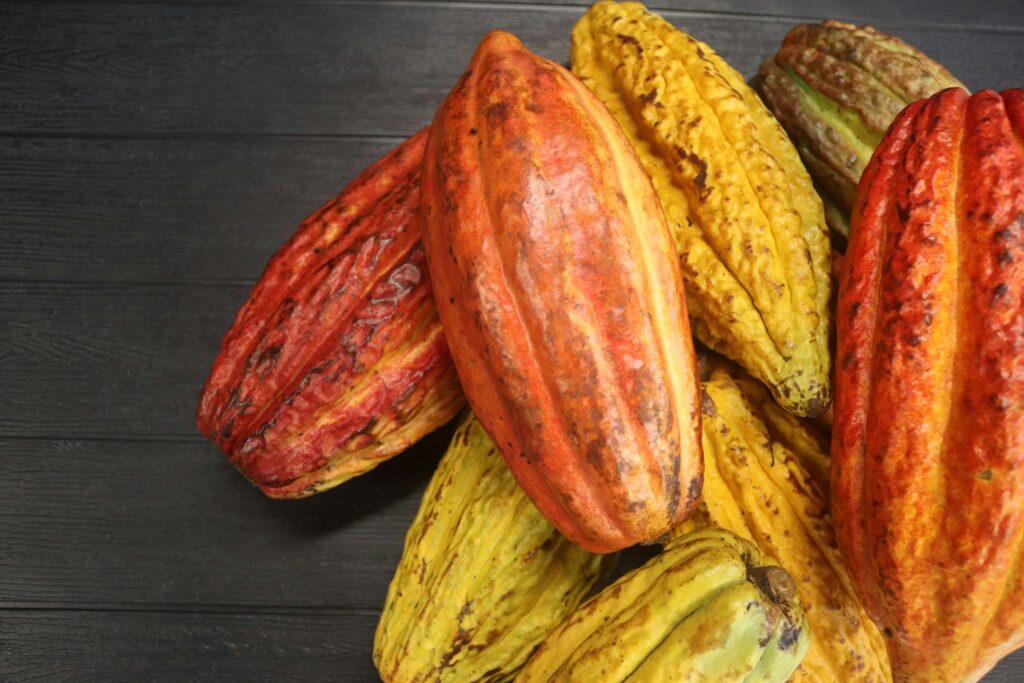
Take a Chocolate Making Class
Saint Lucia offers a variety of engaging chocolate-making classes that let visitors dive into the island’s rich cacao heritage. At places like Project Chocolat on Rabot Estate and Fond Doux Eco Resort, guests can learn the bean-to-bar process, craft their own chocolate bars, and taste fresh local cacao. The Chocolate Laboratory at Jade Mountain Resort offers workshops featuring chocolate tastings and truffle-making, while Cacoa Sainte Lucie provides hands-on sessions that include tasting cacao fruit and enjoying cocoa-infused meals. These experiences combine education, culture, and delicious treats, making chocolate-making a must-do activity for anyone visiting Saint Lucia.
Explore Pigeon Island National Landmark
Located at the northern tip of Saint Lucia, Pigeon Island National Landmark is a 44-acre historical site offering a blend of natural beauty and cultural heritage. Once an isolated islet, it was connected to the mainland in 1972 via a man-made causeway. Today, visitors can explore the preserved ruins of British military forts, including Fort Rodney, which offers panoramic views of the island and the Caribbean Sea. The landmark also features two beautiful beaches, hiking trails, and picnic areas, making it a perfect spot for relaxation and exploration.
The entrance fee to Pigeon Island is $8 USD for adults and $3 USD for children aged 5 to 12. Facilities within the park include restrooms, a gift shop, and a café, ensuring a comfortable visit. The park is open daily from 9:30 AM to 4:00 PM.
Eat at a Restaurant with a View of the Pitons
Dining in Saint Lucia offers not only delicious food but also breathtaking views of the iconic Pitons. Among the top restaurants providing such vistas is The Mango Tree Restaurant, located within the Stonefield Villa Resort in Soufrière. This open-air eatery serves fresh, organic dishes sourced from its on-site farm, offering a true farm-to-table experience. If you are not staying at the resort, just ask the guard at the gate if they are able to seat you. We went several times and never got turned away. Guests can enjoy themed nights like Creole evenings with live local music. The average cost per person ranges from $20 to $30 USD, making it an affordable yet memorable dining option. Kids are welcome here, and they also have a swimming pool inside the restaurant!
For those seeking a luxurious dining experience, Dasheene Restaurant at Ladera Resort provides an upscale ambiance with panoramic views of the Pitons. The menu features a fusion of Caribbean and international cuisines, with dishes crafted from locally sourced ingredients. Average meal prices range from $50 to $70 USD per person. This restaurant is adults only, so if you’re traveling with children, this won’t be the best fit for you.
When planning to dine at these establishments, I’d recommend you make reservations in advance, especially during peak tourist seasons. Dress codes vary, so checking with the restaurant beforehand can ensure a comfortable experience.
Attend a Local Event and Experience Saint Lucian Culture
If you’re visiting Saint Lucia and want to truly experience the island’s vibrant culture, attending local events is a must. Start with the famous Gros Islet Friday Night Fish Fry, where every week the streets come alive with Caribbean music, sizzling barbecues, and deliciously grilled seafood. It’s a friendly and festive atmosphere where both tourists and locals come together to eat, dance, and celebrate life.
Another highlight is the Saint Lucia Jazz & Arts Festival, held annually, last scheduled from April 30 to May 11, 2025. This event draws music lovers from around the globe to enjoy performances by international and local artists across genres such as jazz, reggae, and Afro beats, complemented by art exhibitions and cultural showcases. If your visit aligns with July, don’t miss the vibrant Saint Lucia Carnival, a colorful and energetic celebration featuring parades, live music, dancing, and stunning costumes that capture the island’s dynamic spirit.
To discover more local events during your stay, regularly check Saint Lucia’s official tourism website, Eventbrite’s local listings, or simply ask your hotel concierge or AirBNB host for recommendations. Engaging in these activities not only enriches your trip but also offers an authentic glimpse into the heart and soul of Saint Lucian life.
Take a Boat Ride
Last, but certainly not least, one of the most unforgettable ways to explore Saint Lucia’s stunning coastline and iconic landmarks like the majestic Pitons is from the sea! Costs vary depending on your preferences, with group catamaran cruises usually priced between $125 and $145 per person for a full-day adventure including lunch and snorkeling gear. For a more exclusive experience, private speedboat charters start around $225 per person for a half-day trip, while luxury private catamaran sails can begin at approximately $200 per person. Romantic sunset cruises offer a more budget-friendly option, starting at about $75 per person, making boat excursions accessible to a variety of budgets and travel styles.
Food to Try in Saint Lucia
Saint Lucia’s culinary scene is a vibrant blend of African, French, and British influences, offering visitors a delightful array of flavors. The island’s national dish, green fig and saltfish, features salted codfish sautéed with onions, peppers, and spices, served alongside boiled green bananas (locally known as “green figs”). This dish, rooted in the island’s history, is enjoyed year-round and holds a special place during cultural celebrations like the Creole Day Festival (Jounen Kweyol) in October.
Beyond the national dish, Saint Lucia offers a variety of local specialties. Bouyon, a hearty one-pot stew made with meat, ground provisions, and vegetables, is a staple at gatherings. Lambi, or conch, is often grilled or stewed, showcasing the island’s seafood bounty. Other popular dishes include callaloo soup, made from leafy greens and coconut milk, and accra, savory fritters typically made with salted cod.
The island’s fertile volcanic soil yields an abundance of tropical fruits. Depending on the season, visitors can enjoy mangoes, papayas, pineapples, soursops, passionfruit, guavas, and coconuts. Bananas, a significant agricultural export, are widely available and feature prominently in local cuisine. Other exports include mangoes, avocados, and cocoa beans, reflecting the island’s rich agricultural heritage.
For an authentic taste of Saint Lucia, explore local markets and eateries where these dishes and fruits are freshly prepared, offering a true flavor of the island’s culinary traditions.
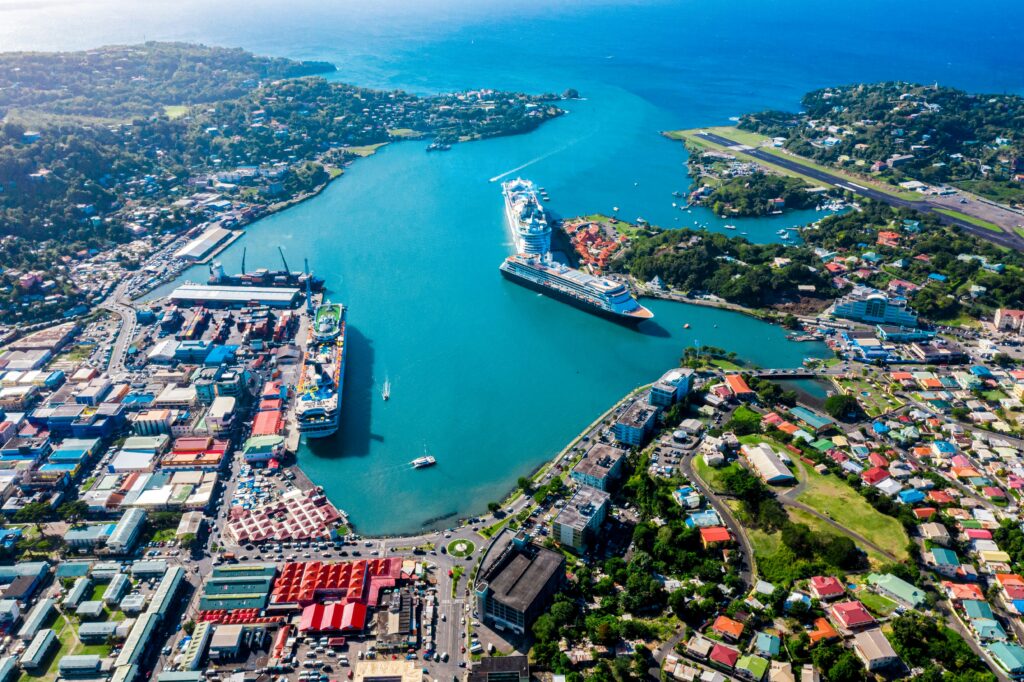
Where to Stay in Saint Lucia
When planning your stay in Saint Lucia, consider the unique experiences each region offers. Soufrière, located on the island’s southwest coast, is ideal for nature enthusiasts and adventure seekers. This area is home to iconic attractions like the Pitons, Sulphur Springs, Diamond Falls Botanical Gardens, and more. Accommodations here range from luxury resorts such as Jade Mountain and Ladera Resort to more budget-friendly options like guesthouses and bed-and-breakfasts . Staying in Soufrière provides easy access to hiking trails, snorkeling spots, and cultural sites.
For a more tranquil experience, Castries, the capital city, offers a blend of urban convenience and serene beaches. Areas like Choc Beach and La Toc Beach are known for their calm waters and are perfect for relaxation. Castries also provides opportunities to explore local markets, historical sites, and enjoy authentic Saint Lucian cuisine. Accommodations here include hotels, guesthouses, and vacation rentals that cater to various budgets.
Travelers seeking a more immersive cultural experience might consider staying with locals through platforms like Couchsurfing or by renting a room only on AirBNB. This option not only offers free accommodation but also the chance to connect with residents and gain insider knowledge about the island.
We opted to rent a villa on AirBNB from a local in Castries, and they were valuable in helping us plan our stay by connecting us with local taxi drivers, private chefs, and more. Staying in Castries allowed us to reach the northern tip for the Fish Fry, Pigeon Island, and Rodney Bay in about 30 minutes or so by car. Then, Soufriere was more of a day tip about an hour and a half away by car. This was the perfect option for us!
Typical Costs of a One-Week Trip to Saint Lucia
Cheap – 300 XCD Per Day
This budget includes staying in a private Airbnb room, using buses or walking for transportation, cooking your meals instead of eating out, minimizing alcohol consumption, and enjoying free activities like hiking or visiting beaches. If you plan on drinking alcohol, add an extra 20-30 XCD per day. To further reduce costs, you could stay for free using Couchsurfing.com or use reward points to cover lodging and travel expenses.
Average – 500 XCD Per Day
An average budget includes staying in a private Airbnb apartment or house, mixing between eating out and cooking your own meals, enjoying occasional drinks, treating yourself to at least one nicer dinner, and sometimes using taxis or renting a car for transportation. It also allows for experiences like snorkeling or diving. To save extra money, you can use credit card points to cover travel or accommodation, or look for bundled packages that include tours, transportation, and lodging.
Luxury – 1,200 XCD Per Day
With a luxury budget, you can do basically anything you want, such as staying at top-tier resorts, dining at fine-dining restaurants, enjoying premium drinks, and easily renting cars or hiring private drivers. You could even take helicopter rides between airports, charter full-day boat tours, or experience exclusive activities. At the luxury level, there’s no upper limit—your options are endless!
Cheap Ways to Explore and Save Money in Saint Lucia
How to Save Money in St. Lucia
While St. Lucia is popular with resort and cruise ship visitors, you can still enjoy the island without overspending. Here are some simple ways to cut costs during your trip and allow your daily budget to go further:
- Use a filtered water bottle: Tap water in St. Lucia is generally drinkable, so bring along a reusable bottle. This saves you money and reduces plastic waste.
- Shop at duty-free stores: St. Lucia offers many duty-free shopping options, selling designer items such as jewelry, alcohol, and clothing at discounted prices. If you want to shop, this is the best place.
- Use Credit Card Points: These points can often be used for transportation, lodging, and excursions, so plan accordingly to save some money on more expensive aspects of your trip.
- Book activities online: Plan ahead by booking expensive activities, like diving or tours, online. Many companies offer special discounts if you reserve in advance.
- Check for deals and offers: Visit the official St. Lucia tourism website regularly. They frequently post seasonal discounts, especially on accommodations.
- Enjoy free natural attractions: Take advantage of St. Lucia’s beautiful beaches, scenic hikes, and stunning sunsets, all of which are mostly free and unforgettable.
- Stay with locals: Consider staying with locals through Couchsurfing.com. It’s a great way to save money on accommodation and experience genuine hospitality from friendly island residents.
How to Stay Safe in Saint Lucia
St. Lucia is generally a safe destination with low levels of serious crime, though visitors should remain aware of their surroundings, as petty theft, especially in busy or touristy areas, can occasionally occur. Always secure your belongings, avoid leaving valuables unattended at the beach, and be cautious when traveling alone after dark. Solo female travelers should feel comfortable exploring the island, provided they follow basic precautions, like never leaving drinks unattended and not walking alone late at night. Local authorities have increased security measures by establishing more police stations, reducing the already low risk to visitors. Personally, my own visit was entirely incident-free.
Hurricane season lasts from June through November, so if you’re visiting during this period, consider purchasing travel insurance or refundable tickets and monitor the weather closely. In emergencies, dial 911 for medical assistance and 999 for police. Lastly, always share your itinerary with friends or family, stay in regular communication, and trust your instincts to ensure a safe, enjoyable trip.
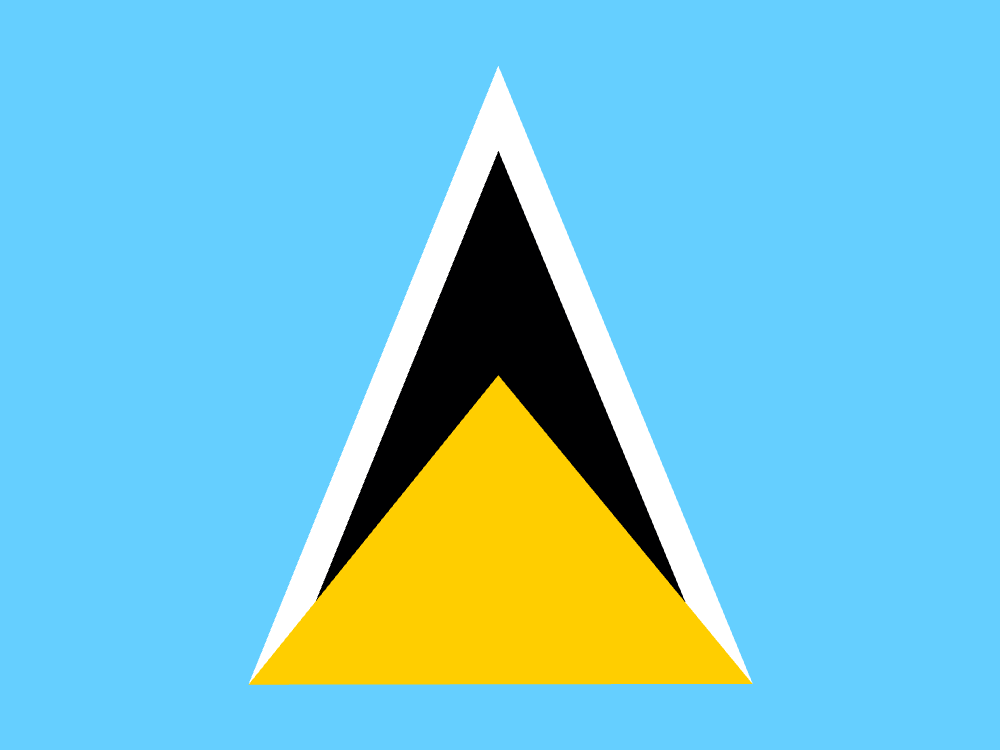
Facts About Saint Lucia
- Capital: Castries
- Official Language: English
- Population: 179,285 (based on 2023 Census)
- Currency: Eastern Caribbean Dollar (XCD) | Exchange Rate
- Time Zone: Atlantic Standard Time (GMT-4)
- Electricity Plug Type: Type G
- Drive on the: Left

